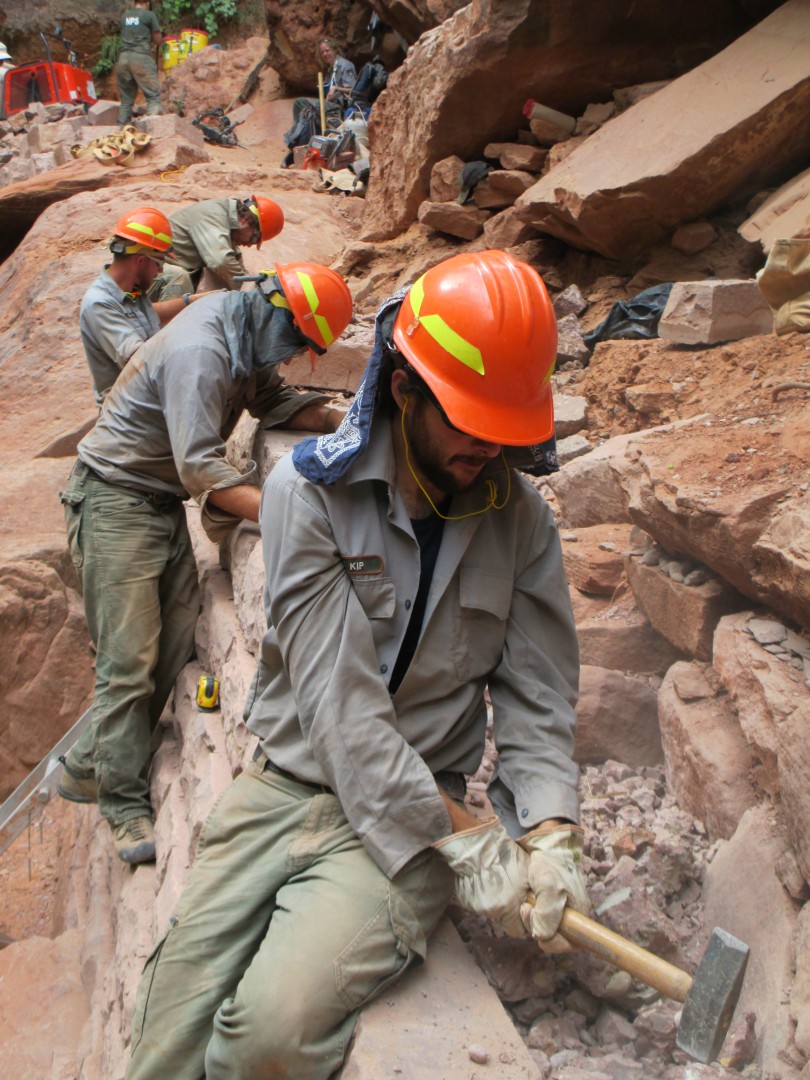
ZION NATIONAL PARK — Longer than Wall Street and taller then the Empire State Building, Zion National Park’s span of sheer cliffs envelops a few incredible foot paths that reach from the bottom to the top of Zion canyon. One of these paths – the Observation Point trail built in the 1920s – will undergo a major overhaul beginning this summer.
The rehab project will continue over the next three years as Zion trail crews remove, refurbish and rebuild the network of trails surrounding Observation Point, which includes Weeping Rock, Hidden Canyon and other branches of the trail system.

This summer’s phase of reconstruction will intermittently close down the lower and middle sections of the Observation Point and Hidden Canyon trails. These sections are very steep, with dizzying height exposure in some places. The trail shoulders the mammoth Zion walls along sections of long hairpin switchbacks, zig-zag stone stairways, and narrow ramps all built by trail crews.
These trails are so structurally dependent that without the structures there would be no trail at all, Zion Trail Crew Supervisor James Brown said. The structures include retaining walls, drainage structures, endless rock steps, and long, paved concrete sections, all of which will be rebuilt or refurbished.
Trails over time
Originally built over a 15-year period starting in the mid 1920s, the Observation Point and Hidden Canyon trails were significant engineering feats for their time. In fact, these trails are on the National Historic Register – a United States listing of nationally recognized historical items – and, Brown said, currently these historical paths are in major disrepair.
Of concern this year specifically, Brown said, are retaining walls that suffered major damage from seasonal rains in the summer of 2013. Even before last year’s rains, damage to the trails has been accumulating since the trail was built, accelerating with increased visitation to the park.
“If we don’t deal with it now,” he said, “we could lose it.”
In fact, this section of trails hasn’t seen any major refurbishments since the 1920s other than a 1970s resurfacing by the Student Conservation Association.

Historically, Zion trail crews have been made up of two or three folks who just did what they could to keep the trails going. Until the last five years, the park just hasn’t had the manpower to fully refurbish trails, Brown said.
Roads and Trails Supervisor Stan Belinte said that lots of repairs should have been done, it’s just never happened. The lack of preventative maintenance has caused even bigger issues.
“We’re playing catchup,” Belinte said, “and hopefully we’ll get those trails up to good standards.”
Five years ago, Zion started its catchup effort by increasing its trail crew. It now includes about 20 members, most of who work seasonally from April to September. The crew’s wages are paid by funds generated through park visitor entrance fees – approximately 3 million visitors a year.
The rehab process
Because of the terrain, crews have to get creative. Along with traditional hand tools, they use power tools like wheelbarrows with motors to haul material up and down the trails.
“Basically we’re peeling off all the old layers of concrete,” Brown said.
Next, he said, the crew will assess the structures that hold up the trail – the stuff that you don’t necessarily see as you walk over it such as retaining walls and the drainage systems.
And last, they will make needed repairs and lay down the new tread which may consist of concrete, gravel, dirt or even large rocks.
Closure details mid-June through October
The Hidden Canyon trail will be most affected by the construction, and the following are expected closures, with some overlaps:
- The Hidden Canyon Trail, portions of the East Rim Trail and the first section of the Observation Point Trail just past Weeping Rock: Closed the first few days of each week June 16 through Sept. 30 (to allow newly-poured concrete to dry). Trails open most weekends during this period.
- The Hidden Canyon Trail will remain closed July 7 through August until retaining wall repair is completed.
- The Canyon Overlook Trail: Closed Monday-Thursday during September and October.
Signage will be placed at the trailheads, the Zion Visitors Center and the Human History Museum during construction to warn visitors when the trails will be under construction. Messages will also go over the speakers on the shuttle busses.
Related Posts
- Drone harasses bighorn sheep at Zion National Park
- True tales of death, misadventure in Zion National Park
- Climbing expedition spends three days in an empty Zion National Park
- Zion-Bryce tour guide
Email: [email protected]
Twitter: @STGnews
Copyright St. George News, SaintGeorgeUtah.com LLC, 2014, all rights reserved.